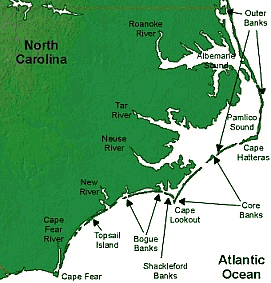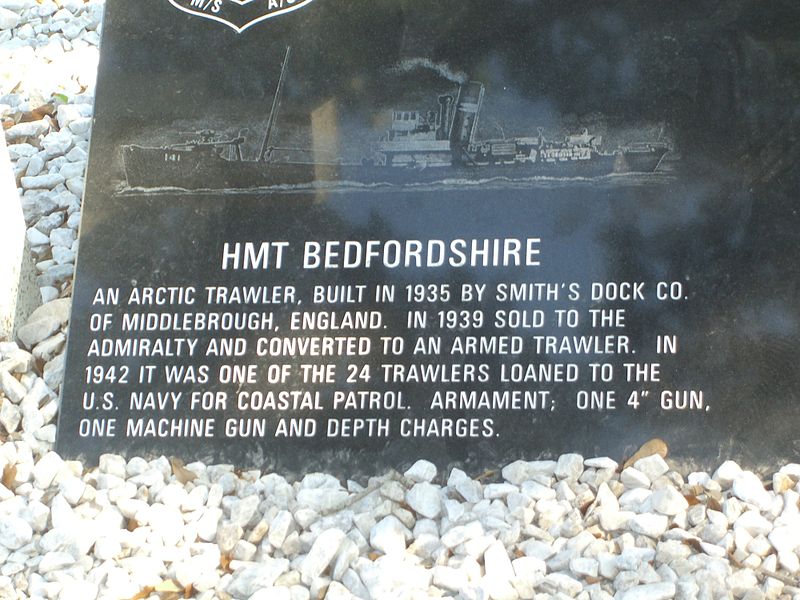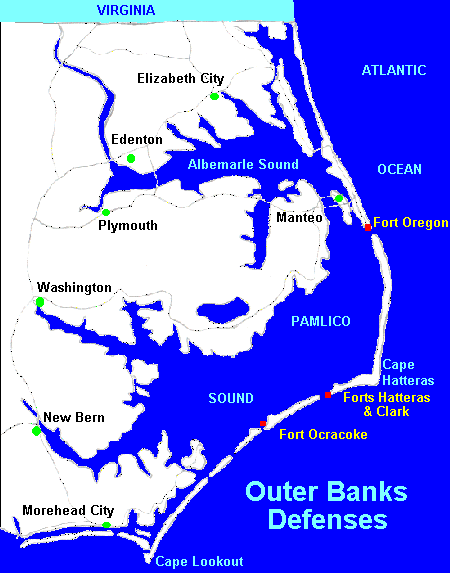|
Tornado Alley History
Torpedo Alley and the North Carolina Outer Banks
Torpedo Alley
In World Wars I and II, German U-boats hunted and destroyed ships off the
Outer Banks. This was "Torpedo Alley," where Germans enjoyed their "Great American Turkey
Shoot." From January through July 1942, German U-boats sank 397 ships filled with food, supplies, and oil in U.S.
Atlantic waters and killed 5,000 people--a majority of whom were civilians and merchant marines. The U.S. concentrated
initial naval efforts in the Pacific. Only one ship was sent to patrol the United States' southeast coast. To protect American
lives and vital supplies bound for England, Churchill sent a flotilla of anti-submarine craft to patrol Atlantic shipping
lanes. One particular ship, the H.M.T. Bedfordshire*, was torpedoed by a U-boat 40 miles off Cape Lookout on May
11, 1942. All hands were lost. The bodies of four sailors washed ashore on Ocracoke. Donating their services and land for
this British Cemetery, the people of Ocracoke took care of the dead. This plot of land has been forever ceded to England and
is maintained by the Ocracoke Coast Guard. A ceremony honoring these men, with representatives of the British Royal Navy and
the U.S. Coast Guard, is held at the location each year in May.
*HMT Befordshire is often referred to as HMS Bedfordshire. HMT is "His
Majesty's Trawler", while HMS is "His Majesty's Ship." Referring to the Bedfordshire as HMS, is a gesture of respect.
| Torpedo Alley Map |

|
| (Map) Torpedo Alley and Outer Banks, North Carolina |
(Right) Outer Banks and Torpedo Alley
Outer Banks in History
The Outer Banks (also known as OBX) is a 200-mile (320-km) long string of
narrow barrier islands off the coast of North Carolina and southeastern Virginia. They cover most of the North Carolina coastline,
separating the Currituck Sound, Albemarle Sound, and Pamlico Sound from the Atlantic Ocean.
Prior to Torpedo Alley, the Outer Banks was prominent during the American
Civil War (1861-1865). The location was critical for the shipment of supplies between Europe and the Southern states. With
a formidable Union blockade of the Southern coast, opposing navies often fought for control of the Outer Banks. (See
also Blockade of the Carolina Coast and Anaconda Plan.)
| Torpedo Alley off Outer Banks of North Carolina |

|
| A plaque on Ocracoke Island commemorating those killed on HMT Bedfordshire. |
| Torpedo Alley History |

|
| (Map) Outer Banks during the American Civil War |
(Right) Map of Outer Banks indicating Confederate forts during
the American Civil War (1861-1865)
The Wright brothers' first flight in a powered, heavier-than-air vehicle
took place on the Outer Banks on December 17, 1903, at Kill Devil Hills near the seafront town of Kitty Hawk. The Wright Brothers
National Monument commemorates the historic flights, and First Flight Airport is a small, general-aviation airfield located
there.
The English Roanoke Colony—where the first person of English descent,
Virginia Dare, was born on American soil—vanished from Roanoke Island in 1587. The Lost Colony, written and performed
to commemorate the original colonists, is the longest running outdoor drama in the United States and its theater acts as a
cultural focal point for much of the Outer Banks.
The treacherous seas off the Outer Banks and the large number of
shipwrecks that have occurred there have given these seas the nickname Graveyard of the Atlantic. The Graveyard of the Atlantic
Museum is located in Hatteras Village near the United States Coast Guard facility and Hatteras ferry.
The Outer Banks is currently a major tourist destination and is known for
its temperate climate and wide expanse of open beachfront. The Cape Hatteras National Seashore has four campgrounds where
visitors may camp.
(Sources and related reading below.)
Recommended Reading: Torpedo Junction:
U-Boat War Off America's East Coast 1942.
Description: Slaughter at sea—just miles from U.S.
soil! In 1942, German U-boats turned the shipping lanes off Cape
Hatteras into a sea of death. Cruising up and down the U.S. eastern seaboard, they sank nearly 400 ships, littering
the waters with cargo and bodies. As astonished civilians witnessed explosions from American beaches, fighting men dubbed
the area "Torpedo Junction." And while the U.S. Navy failed to react, a handful of Coast Guard sailors scrambled to the front
lines. Continued below…
Outgunned and out-maneuvered,
they heroically battled the deadliest fleet of submarines ever launched. Never
was Germany closer to winning the war. In a moving ship-by-ship account of terror and rescue at sea, Homer Hickam chronicles a little-known saga of courage,
ingenuity, and triumph in the early years of World War II. From nerve-racking sea duels to the dramatic ordeals of sailors
and victims on both sides of the battle, Hickam dramatically captures a war we had to win—because this one hit terrifyingly
close to home.
Related Reading:
Recommended Reading: Operation
Drumbeat: The Dramatic True Story of Germany's First U-boat Attacks Along
the American Coast
in World War II. From Publishers Weekly: In 1942, German U-boats sank nearly 400 Allied
ships off the East coast of the U.S., threatening to sever Britain's lifeline and cripple U.S.
war industry. Gannon, a University of Florida
history professor, reveals the appalling degree of unpreparedness and opposition to military intervention on the American
side, despite accurate warnings from British intelligence, and traces much of it to the Anglophobia of the chief of naval
operations, Admiral Ernest J. King. Continued below…
In an impressive research coup,
Gannon located the former skipper and several crew members of one of the U-boats involved in the campaign. Using interviews
with these men and former U.S. and British military personnel, and a war diary of the
U-123 , Gannon recreates two action-packed patrols and the sinking of 18 Allied ships by that submarine. The book will be
of enormous interest to sub warfare buffs. Includes numerous photos. Fans of the movie Das Boot especially won't want to miss
it.
Recommended Reading:
Graveyard of the Atlantic: Shipwrecks of the North Carolina Coast. Description: This is a factual account, written
in the pace of fiction, of hundreds of dramatic losses, heroic rescues, and violent adventures at the stormy meeting place
of northern and southern winds and waters—the Graveyard of the Atlantic off the Outer
Banks of North Carolina. Continued below...
The author describes some of the most climatic sinkings such as the USS Huron, the SS Metropolis, and the
steam packet Pulaski. He also chronicles the birth and growth of the US Life Saving Service and some of the most exciting
rescues in history. Overall this is a fine and engrossing book, written by an author intimately connected with his topic.
Includes illustrations, maps, and drawings.
Recommended Video: Quest for Sunken Warships: "Torpedo Alley",
Military Channel, 45 minutes. Description: In 1942 German U-boats turned the waters off Cape Hatteras North Carolina into
a sea of death. For six months the marauding U-boats patrolled the area unchallenged, sinking countless ships that littered
the ocean and beaches with oil, cargo and bodies. Continued below...
From the North Carolina
coast to the South Pacific, Quest for Sunken Warships journeys beneath the waves to investigate the shipwrecks and stories
forgotten by history. Expert wreck divers explore the world to uncover American history in underwater graveyards of iron and
steel. Combines CGI illustrations, archival battle materials, and on-site diver exploration of the sunken wrecks.
Recommended Viewing: Das
Boot - The Original Uncut Version (DVD) (1982) (293 minutes) (Release Date: June 1, 2004) (Nominated for 6
Oscars). Description: While the director’s cut of Das Boot is a staggering 209 minutes, this Uncut Version
(nearly 5 hours!) includes an additional 84 minutes! This 293-minute version of Das Boot is the full-length
TV series, originally shown in six parts but here edited into a seamless whole. Award winning director Wolfgang Petersen and
his sterling cast (including Jürgen Prochnow in his best role as the U-boat Captain) went to great lengths to ensure that
this claustrophobic depiction of life aboard the German sub U-96 while attacking British convoys in the Atlantic is thoroughly authentic,
and totally convincing. Continued below...
Even the set itself, which is a replica of a U-boat interior, had no false walls, so all camera angles are
necessarily from within its horribly narrow, overcrowded and sweaty confines. The result is certainly the finest submarine
drama ever made, and one of the most compelling depictions of the physical, psychological and emotional effects of warfare.
This gripping tale from Academy AwardŽ nominated director Wolfgang Peterson follows the daring patrol of U-96 – one
of the famed German U-boats known as the "gray wolves." The crew aboard the U-96 is graphically portrayed
in a desperate life and death struggle coping with endless hours of claustrophobic boredom at sea which quickly gives way
to terror when confronting the enemy. Das Boot delivers an amazingly accurate account of Germany's
elite U-boat crewmen as it deliberately depicts the carnage of war. At nearly 5 hours of run time, order a pizza, grab the
popcorn, reach for that favorite drink and enjoy one of the greatest classics ever brought to the screen!
ALSO CONSIDER: Das Boot -
The Director's Cut (DVD) (1982) (209 minutes) (Release Date: December 10, 1997). Description: This is the restored, 209-minute
director's cut of Wolfgang Petersen's harrowing and claustrophobic U-boat thriller, which was theatrically rereleased in 1997.
Originally made as a five-hour miniseries, this version devotes more time to getting to know the crew before they and their
stoic captain (Jürgen Prochnow) get aboard their U-boat, U-96, and find themselves stranded at the bottom of the sea.
Continued below...
Das Boot puts you inside that submerged vessel and explores the physical and emotional tensions
of the situation with a vivid, terrifying realism that few movies can match. As Petersen tightens the screws and the submerged
ship blows bolts, the pressure builds to such unbearable levels that you may be tempted to escape for a nice walk on solid
land in the great outdoors--only you wouldn't dream of looking away from the screen.
Sources: National Park Service;
Library of Congress; National Archives; Official Records of the War of the Rebellion; history.navy.mil; uscg.mil; va.gov;
af.mil; US Navy History, Washington, DC; US Coast Guard History, Washington, DC; Hancock, W.K.; Margaret M. Gowing (1949).
British War Economy. History of the Second World War. London: Her Majesty's Stationery Office;
Empire Gem (British Motor tanker) - Ships hit by German U-boats during WWII"; "Venore
(American Steam merchant) - Ships hit by German U-boats during WWII"; Conn, Stetson (2000) [1964]. Guarding the United States
and Its Outposts. Seattle: United States Army Center of Military History; "NOAA, National Oceanic and Atmospheric Administration.
|

